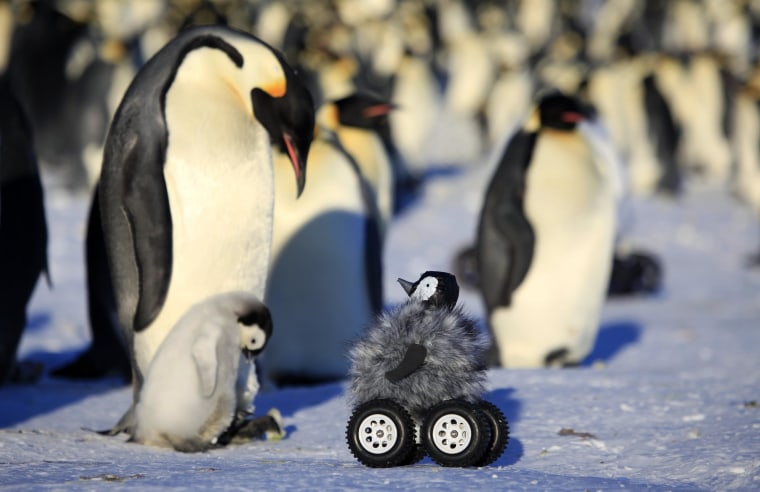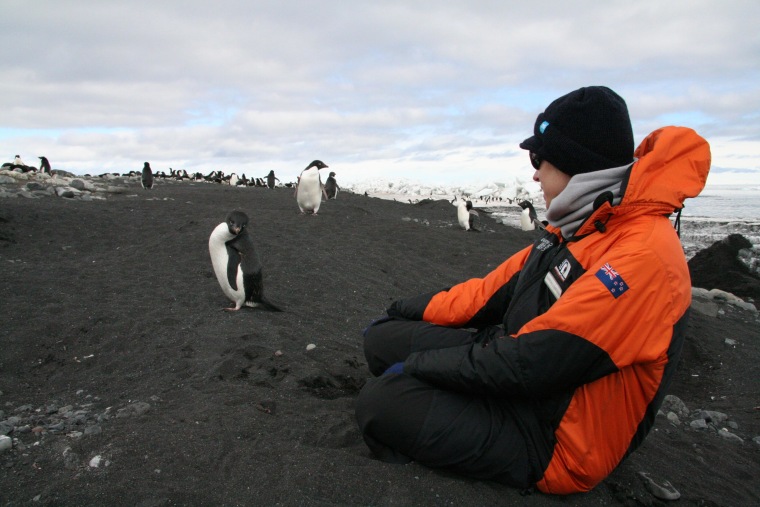A close look at the genomes of two of Antarctica's most famous birds — emperor penguins and Adelie penguins — reveals common genetic traits that allow them to cope with the continent's cold and hostile environment, as well as subtle differences that could shed light on the future of the species.
Both penguins have had starring roles at the movies: the emperors in "March of the Penguins," and the Adelie birds in the "Madagascar" animated films. But they thrive in different habitats, and the scientists who decoded dozens of genomes for the Avian Phylogenetics Consortium were curious whether some of the factors behind those differences are reflected in the penguins' genomes.
Emperor penguins nest almost exclusively on locked-in sea ice — while Adelie penguins are more dependent on a balance of sea ice and open water, because they're best-suited to swim out to feeding grounds on Antarctic ice floes. Last year, researchers reported that Adelie populations were highly sensitive to minor changes in the amount of sea ice due to climate shifts.
The newly published results, appearing in the open-access journal GigaScience, support the view that Adelie penguins are more subject to population booms and busts than emperor penguins. The genetic record indicates that the Adelie penguin population increased rapidly about 150,000 years ago, when the climate became warmer. The population then dropped by 40 percent about 60,000 years ago, during a cold and dry glacial period.
Emperor populations, meanwhile, remained relatively stable.
"These different patterns in historical population change also suggest that future climate change may have impacts on the two penguin species," BGI-Shenzhen geneticist Cai Li, the paper's principal author, said in a news release. "For example, the fact that emperor penguins didn't experience the same population boom as Adelie penguins in warm climates means that they could suffer more from global warming."
Such a possibility should be considered in formulating conservation efforts for Antarctica, Li said.
Prognosis for the penguins
Scientists found that the two species exploited different genetic strategies for metabolizing lipids as they evolved — which suggests they're built to store fat in different ways during long fasting periods. That mechanism may help explain the different responses to climate change.
David Ainley, a researcher at H.T. Harvey and Associates who was not involved in the genetic analysis but played a lead role in the study of climate effects on Adelie penguins, said the GigaScience analysis was "interesting."

"I think the finding most relevant to immediate times and the near future is related to the relative stable population of the emperor penguins compared to the Adelie penguins over the long term," Ainley told NBC News in an email. The research implies that "in order to maintain their population size through the eons, emperor penguins had to have moved their colonies quite frequently," he said.
Some researchers have warned that climate shifts will cause a dramatic drop in the emperor penguin population by the end of the century, but Ainley said the genetic findings suggest that the outlook is more complex.
"It's not that climate change and loss of sea ice will not ultimately negatively affect these high-latitude, ice-obligate species, but that the predicted timing is likely to be off, as well as the process," he said.
What sets penguins apart?
The gene-sequencing team also found factors that set both species apart from other birds. Both penguins had expanded genes related to beta-keratins, proteins that make up 90 percent of feathers. At least 13 of the penguins' genes were responsible for a single type of beta-keratin. That points to the importance of short, stiff, strong, densely packed feathers to prevent heat loss and repel water while swimming.
Another gene, known as DSG1, has been linked in humans to a dermatological disease that causes an abnormal thickening of the skin on the palms and soles. In penguins, this gene may contribute to thicker insulation from the cold.

Yet another gene found to have undergone significant evolutionary change, EVC2, causes short-limb dwarfism and short ribs in humans. That gene and others may be linked to the development of penguin wings that are adapted for swimming but not for flight, the researchers said.
"Penguins show distinct evolution relative to other bird species," Guojie Zhang, associate director at BGI-Shenzhen's China National GeneBank, said in Thursday's news release. "They can't fly, have specialized skin and feathers, degenerated wings and live in a cold environment in which most other birds could not survive. Comparative genomics is a powerful tool for providing answers on the molecular basis of these evolutionary changes and how organisms deal with the conditions they are exposed to."